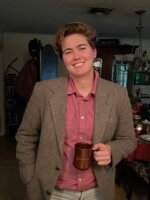The winning design team drew inspiration from Dallas' Klyde Warren Park: construct a deck over the busy road that holds green space, social spaces and paths for pedestrians.
Patricia Cerda was part of the first place team, Mav Tracers. She said the group's design was also influenced by UTA's 2005-2020 Master Plan, which also proposed a plaza over Cooper Street.
"We were like, 'Well, they thought about it, too, so it can't be a crazy idea,'" she said.
Cerda's group was one of 40 that pitched redesigns of UTA's north and south bridges. The Mav Tracers and other groups that placed will meet with the design team the city selects for the project.
Both university and city leaders have grappled with safety and campus recognition along Cooper Street for decades. The university constructed the bridges, and the roadway was lowered in 1989 four months after graduate student Andy Beck died while crossing at street level. In 2016, college senior Eneyda Lisette Sorto was also struck and killed crossing the street.

The university observed a "rising toll of injuries" along the street between the 1960s and 1980s, according to the library's curated history of UTA accessibility. Student groups in the '80s petitioned to reduce the speed limit along Cooper Street to 20 miles per hour during heavy pedestrian traffic.
Former President Wendell Nedderman called the street "an open sore running through campus," according to the UTA library.
Additionally, the barrier walls and bridges don't make it easy for commuters to recognize that they are driving through campus, Cerda said.
"It was so wild to me when people would talk about how, 'I've lived in Arlington all my life and I go down Cooper and I never knew there was a university there,'" she said.
University President Jennifer Cowley said she launched the competition as UTA planned to update the bridges. They're also a way to involve the community in building a more pleasant and recognizable space.
"This bridge is not just about UTA, it's about our community as a whole and making sure that our community feels like they're getting a gateway," Cowley said.
She said the Mav Tracers' Klyde Warren Park-inspired redesign was a common theme during the competition, as well as designs that more clearly marked the underpass as UTA campus.
"Whether that's through lights or murals or other kinds of iconography, they were really about, 'How can we tell the story of UTA through these bridges?'" Cowley said.
The competition challenged students to create a multi-phase project.
Mav Tracers' phase one would include soliciting murals and project advertising, identify green space for future development and improve lighting on the walkway during the first year of construction.
Cerda said her group decided that leaving the project at bridge beautification would not address the university's desire for a greater connection between the two parts of campus.
"That was a conversation that we had within our team that it felt like, 'Yes, the university could make these bridges nicer and prettier and flashier, but if you leave them as is, they're not really connecting anything," she said.
Update: This story's photo caption was updated at 9:17 p.m. CST Feb. 24, 2023, to include the name of team member Lekammrun Woods.
Got a tip? Email Kailey Broussard at kbroussard@kera.org. You can follow Kailey on Twitter @KaileyBroussard.
KERA News is made possible through the generosity of our members. If you find this reporting valuable, consider making a tax-deductible gift today. Thank you.





